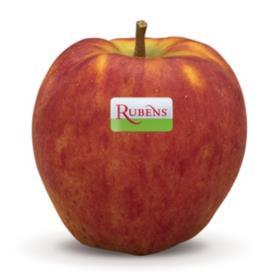
A near perfect growing season, combined with British consumers showing an increased preference for English-grown apples, looked set to deliver an excellent harvest for growers of the club variety Rubens when picking began during the last few days of September. In just three years, the UK public has responded favourably to the high-quality, red-skinned cultivar, which offers intense flavour and a 'unique crunch'. As a result, Rubens volumes were set to increase by 25 per cent year-on-year to 850 tonnes this autumn.
The popularity of Rubens is mirrored by interest in other new apple varieties too, as British consumers continue to show an increasing preference for homegrown fruit which has prompted targeted advertising campaigns from the likes of Tesco, Sainsbury's and Waitrose. According to national statistics from English Apples & Pears Ltd, UK growers currently produce over one-third of the total supply (34.1 per cent), and with the total market worth £902.2m (€1.07bn), the English apple and pear market is now worth around £300m (€355m). Total Class I production has also increased in the UK, rising from 85,726 tonnes in 2007/08 to 91,763 tonnes in 2009/10.
So with the 21st National Apple Day approaching on 21 October, does the apple industry have reason to celebrate a general renaissance forEnglish grown apples?Sarah Calcutt, business development manager at topfruit marketer Norman Collett and the first female chairman of The National Fruit Show believes so. 'There has been more investment in the last ten years in orchards than at any time in the previous 30,' she explains. 'Acreage has started to increase again, the number of new varieties coming forward is starting to rise rapidly and the offer to the customer can only be better as a consequence.Fruit quality is increasing too, as is availability of British favourites and popular new varieties, Ms Calcutt adds. 'The British public is waking up to the fact that English apples are quite simply much more tasty, and when it comes to taste and texture Rubens is scoring very high with English palates.'
Growers predict an excellent harvest for Rubens this year. James Smith, managing director of Loddington Farm in Kent, in the south of England, has 10 acres devoted to Rubens and is looking forward to doubling last year’s harvest by delivering 80 tonnes compared with 40 tonnes in 2009. 'Rubens has had the correct levels of sunlight during the summer, which will ensure plenty of sugar has developed and the cold nights are now bringing on great colour in the skins,' he confirms. 'We have just been to the orchards to see how close to picking we are and some fruits were testing at 14 per cent sugar content which is really excellent, the flavour is fantastic too.'
Some experts reckon the flavour of all apple varieties this season will be the best since the late 1970s and overall the English apple market is expected to perform particularly well this year, as poor weather in France means the forecast crop in continental Europe is down by almost 20 per cent on 2009/10.
Meanwhile, Rubens has been named as the best eating apple from a selection of new apple varieties judged by top chef Raymond Blanc. Supported by what growers describe as perfect production and ripening conditions, the variety is set to be harvested in record volumes in the UK this year. As well as the intense flavour and crisp texture, the variety is rich in vitamin C, antioxidants and has just 66 calories per apple, making it all the more marketable to consumers.
'This year really has been fantastic for the Rubens,' says Nigel Jenner, technical director at Norman Collett. 'The cold winter was good for orchards as the trees went properly dormant, allowing them to rest and store their reserves for blossom time.' Subsequent summer temperatures reportedly rose at exactly the right time to coincide with the fruit-set stage in late May and early June and the exceptional levels of sunshine in June and July apparently induced ripening with very high sugar levels. As Mr Jenner confirms, an optimum balance between the hot weather and rain was accompanied by large day/night temperature differentials since the second week in September. 'The cold night-time temperatures will initiate a fantastic red colour in the Rubens just before they are picked from the trees,' he predicts.



